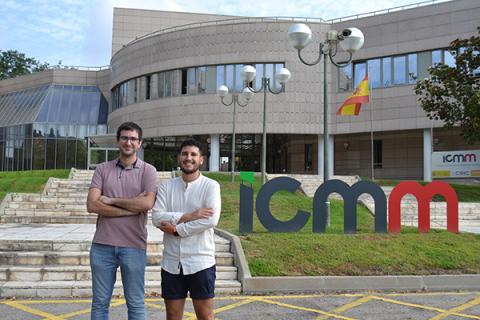Álvaro Gallo and Víctor García, Extraordinary Doctoral Award at the Autonomous University of Madrid

The Permanent Commission of the Doctoral School at the Autonomous University of Madrid has published the Honorable Mentions for Doctoral Studies (Extraordinary Doctoral Awards) for the theses defended during the academic year 2021/2022. Among those mentions, there are two researchers from the Materials Science Institute in Madrid (ICMM), CSIC: Álvaro Gallo and Víctor García Gisbert.
Álvaro Gallo has been the sole recipient of the extraordinary award within the program of Advanced Materials and Nanotechnology / Physics of Light and Matter. "It's an honor," he says with a smile on his face. The young researcher has also received the runner-up prize in the Margarita Salas Research Awards for his thesis on materials for water decontamination. "These awards are a way to motivate young scientists to continue on this path," he asserts.
His thesis was titled "Magnetic Nanoreactors: Environmental Catalysis Applications" [Nanorreactores Magnéticos: Aplicaciones en Catálisis Ambiental], supervised by Puerto Morales Herrero and Jesús García Ovejero, and obtained a distinction with honors (Cum Laude) and an international mention. In his research, Gallo aimed to "contribute our bit to find solutions to problems such as climate change and environmental pollution."
To achieve this, he utilized magnetic materials based on iron oxide nanostructures. "These structures are capable of trapping contaminants found in water and transforming them into other compounds that are not harmful to the environment," explains the researcher, emphasizing that the magnetic nature of these nanoparticles allowed for the separation of contaminants "simply by using a magnet, resulting in an efficient, simple, and clean process."
Meanwhile, Víctor García Gisbert has become the first recipient of the extraordinary award in the program dedicated to Condensed Matter Physics, Nanoscience, and Biophysics. In his case, there were two mentions planned out of the 21 theses presented this year at UAM within that program. "These awards greatly encourage you to continue," affirms the young researcher, fully in agreement with his colleague. "You see that what you do is worthwhile, that it is valued," he adds.
The thesis, titled "High Spatial Resolution Nanomechanical Mapping of Materials: From Proteins to Magnetic Media," focuses on developing atomic force microscopy techniques for measuring samples at the nanoscale. "We have evolved the technique; we have demonstrated that the microscope is capable of measuring things that were previously impossible," asserts the researcher.
During his years at ICMM, this young investigator has studied the potential new methods of atomic force microscopy and how they can be used to measure the mechanical properties of biological forces. Specifically, he has developed new methods for measuring the mechanical properties of proteins, collagen, and lipids. With his technique, he has been able to observe how the mechanical properties of certain substances change over time. "The previous method could measure mechanical properties with a resolution of one minute, meaning one image per minute; now we can measure multiple images per second, improving the technique by 100 compared to previous results," he proudly explains.
Both researchers continue to work hand in hand with their mentors at the center, but they already have their sights set on their upcoming postdoctoral stays. In fact, before the end of the year, García Gisbert will already be traveling to another destination where he will continue learning and contributing knowledge to the world.
-- Ángela R. Bonachera -- Communication Unit --
Instituto de Ciencia de Materiales de Madrid (ICMM)
Sor Juana Ines de la Cruz, 3
Cantoblanco, 28049
Madrid, España
Telephone: (+34) 91 334 90 00
Email: @email
Communication Office: @email

Acknowledge the Severo Ochoa Centres of Excellence program through Grant CEX2024-001445-S/ financiado por MICIU/AEI / 10.13039/501100011033

Contacto | Accesibilidad | Aviso legal | Política de Cookies | Protección de datos